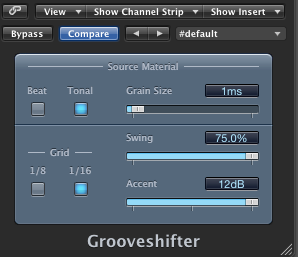 Grooveshifter was one of many new plug-ins included with Logic back when version 8 came out.
Grooveshifter was one of many new plug-ins included with Logic back when version 8 came out.Given what a massive update Logic 8 was, Grooveshifter was among many of the minor new introductions that tended to get lost in the shadow of the radical interface overhaul.
Grooveshifter is a plug-in designed to allow you to add some swing and dynamics to rhythmic material that might not have it in the first place. The results it gives are pretty mixed. Sometimes it works, sometimes it doesn't, and frankly, in light of the impressive time-altering features in software like Spectrasonics Stylus RMX, it seems a bit long in the tooth.
So while it may be outdated as far as doing what it's intended to do, few people take the time to try MISusing it. By using some rather extreme settings, Grooveshifter can turn even the most pristine drum loop into a wildly loping, grainy mess. How useful the results are depend on what you feed it and what style of music you do, but if you're into more experimental rhythms, this is well worth exploring.
The first step is to throw a drum loop on an audio track. Assign Grooveshifter as an effect on the inserts for that track. Since we're working with rhythmic material, you'd assume we'd want to use BEAT mode, but we're abusing this thing, so let's change it to TONAL mode. This lets us play with the GRAIN SIZE parameter which decides the size the bits of audio are chopped up into. Let's bring it all the way down to about 1ms for a sort of grainy, mechanical effect.
Below that are your SWING and ACCENT controls. As you'd expect, SWING adds a rhythmic swing feel to the audio and this slider determines the extent of that swing. Extreme values can yield results that are quite different from what you're feeding it. ACCENT exaggerates the difference between quieter and louder hits, making for more dynamic sounding rhythms. Both of these settings are effected by the GRID which can be set to either 16th or 8th notes. 16th notes tend to give you results a bit more like the original, whereas 8th notes can be a lot more unpredictable.
This doesn't always work out in a usable way, but with the right match between original material and extreme settings, you can get tons of variations on the original loop without a lot of effort. Here's an example of the types of effect you can get with this. The sound clip starts with a couple bars of the uneffected source material, and it is followed by two variations made with extreme settings:




















4 comments:
Awesome post Tom. I'm truly inspired. The only insert on that loop is the Grooveshifter, right? Now this is something new I need to try!
Thanks.
-Tom N
Yeah, in the audio examples, the only effect on them is Grooveshifter.
This website design knowledge installation arrive chock-a-block furtiveness, which is essentially individual of many reasons in place of the developing fame of the software program. Website design in Ohio
Goodness, there is so much useful information above!
Post a Comment